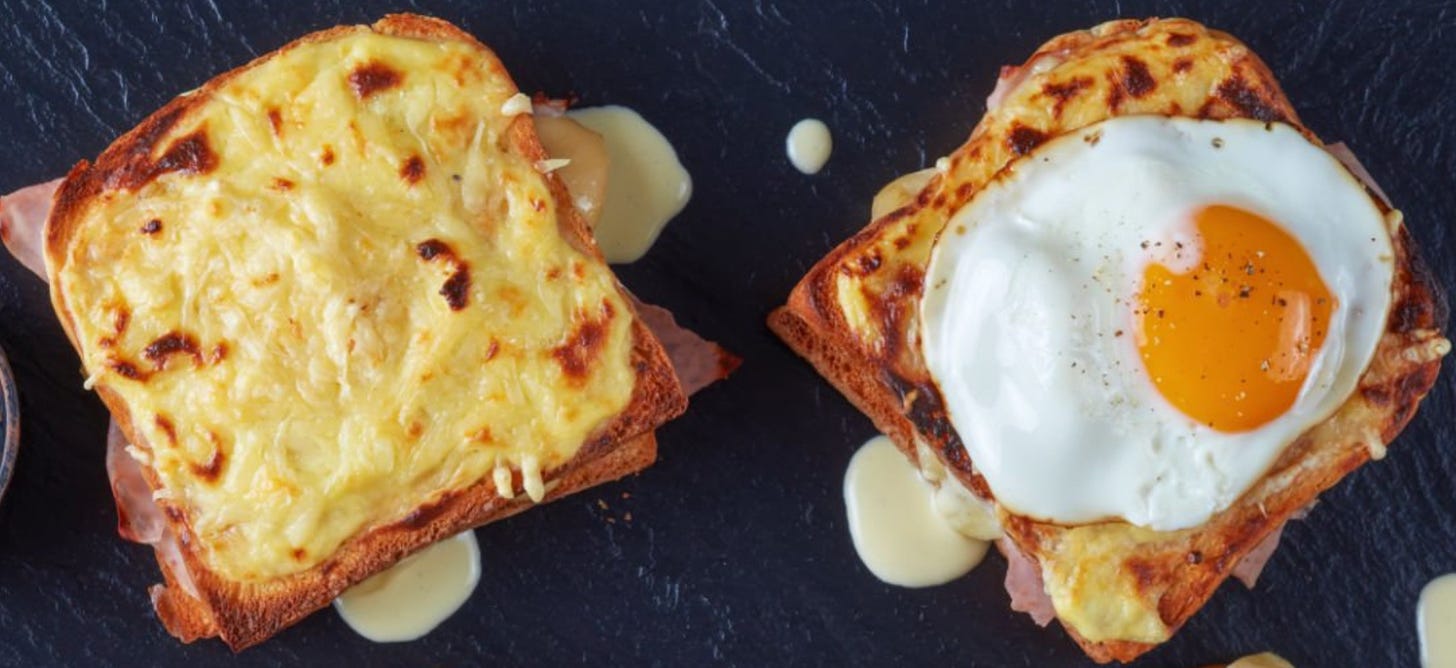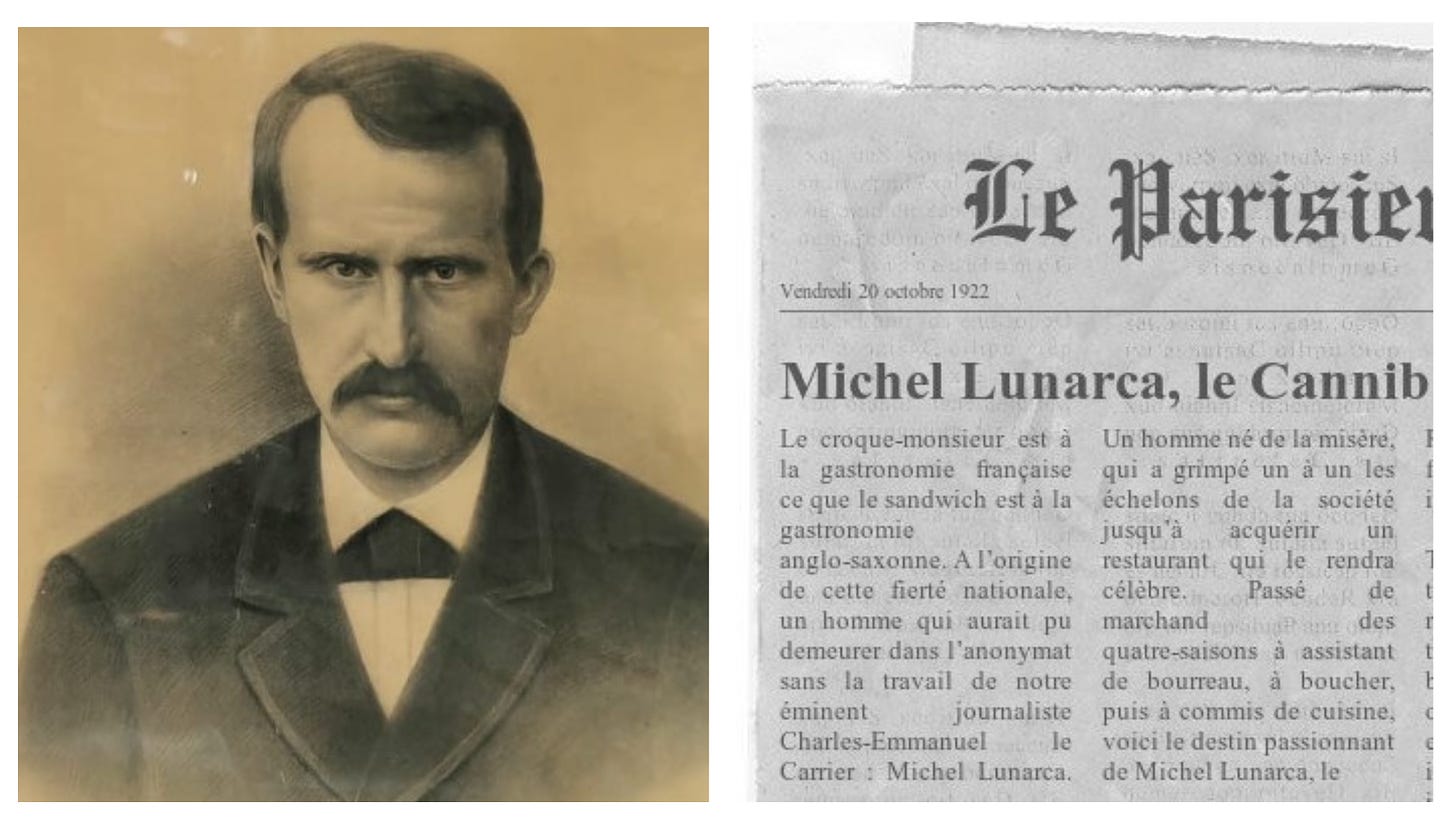Notable Sandwiches #50: Le Croque Monsieur et Le Croque Madame
This whole thing smacks of gender
Welcome to the latest installment of Notable Sandwiches, the feature where I, alongside my editor David Swanson, trip merrily through the bizarre document that is Wikipedia’s List of Notable Sandwiches. Today: a pair of French classics, the croque madame and croque monsieur.
Imagine, if you will, a man and woman lying beside one another, behind a pane of faintly steamed-up glass. They’re practically glowing with heat, and the woman is wearing just a bonnet; the man, a silky robe, bare underneath.
Welcome to France. It’s lunchtime, and you’ve just met the country’s sexiest grandees: Monsieur et Madame Croque. Ubiquitous in the finest boulangeries and brasseries of Paris, this couple is hot as hell and ready to party.
Our tale of two sandwiches begins at the fin de siècle, though the precise origins of the pair are difficult to pin down. One thing is certain: their names translate, roughly, to Mr. and Mrs. Crunchy. From this side of the Atlantic, everything sounds fancier in French.

As with many of the sandwiches in this series, there’s an established narrative to Les Croques, that upon careful examination turns out to be utter twaddle. Published in French newspapers, as well as the bottomless digital junkyard of bad blogs cluttering Google, the myth goes that a restaurateur named Michel Lunarca, who ran the Bel Age café near the Paris Opera, found himself critically short of baguettes and was forced—quelle horreur—to serve a grilled ham and cheese on sliced sandwich bread one day in 1910. This misadventure proved to be a blessing in disguise: the dish caught on and became beloved, blah blah blah. Stop me if you’ve heard this before.
I certainly have. I’m not sure why the idea that fantastic sandwiches must arise by accident instead of premeditated culinary genius is so compelling, but it’s cropped up in the legends of the club sandwich, the carrozza, and many more. At any rate, Lunarca may have been a savvy PR guy—there’s a bizarre sub-legend, repeated in Le Figaro among other French sources, that the sandwich is called the “croque-monsieur” because Lunarca used to joke with customers that it was made of human flesh—but there is textual evidence dating back to the late nineteenth century. The earliest example in the Bibliothèque nationale de France’s collection is a column from an 1887 edition of the socialist-anarchist newspaper Le Révolté, which condemns the “croque-monsieur bearnaise” as an exemplar of the “patrician delights” and “suave adulteries” of the bourgeoisie. Once again: the sexiness of these sandwiches cannot be denied.
The distaff equivalent, the croque-madame, has an even murkier origin, so I will simply go with the bullshit myth on this one: Le Figaro informs us that the egg atop the croque-madame, which is otherwise identical to the croque-monsieur, is meant to resemble a lady’s bonnet.
The couple—slick, square-cut and happy—are destined for love eternal, dressed richly in chic béchamel and Gruyére. They are occasionally joined by the lighter, vegetarian croque-mademoiselle, leading to the notion of an entire society of Crunchies, all demanding to be formally addressed by their titles. This gendered pair isn’t the only term in French cuisine to evoke a certain intimacy: béchamel, velouté, hollandaise, et cetera, are known as “mother sauces”; double-boiling requires one to imagine Marie luxuriating in her bain.
The Sword and the Sandwich is a newsletter about deadly serious extremism and equally serious sandwiches. Please consider supporting this work with a paid subscription:
Eating, of course, is an inherently sensual experience—and can be rendered painful if one feels alienated from one’s body in a thousand different ways. Ham and cheese sandwiches wouldn’t be my top pick for an aphrodisiac—God invented oysters and chocolate soufflés for a reason—but, you know, c’est la vie. I wish them well, and I hope a squalling little croque-garçon comes along soon; you can already get one at this burger joint in Omaha.
Nonetheless, it leaves a sour taste in my mouth to reify the gender binary in this sandwich column, especially when I’ve had such a tormented time with my own gender lately. Making peace with my classically masculine qualities (loud, assertive, argumentative, ambitious, aggressive, et cetera) within a feminine presentation has taken a long time, and it will likely be a lifelong project: to love the things about myself I was conditioned to loathe, to allow patience, generosity, and capacity in one’s own self-understanding.
One has to reconcile oneself with being neither one thing nor the other, entirely—neither all madame nor all monsieur. In some ways the door to transition will always hang invitingly open in my mind, even if I never, ever want to stop wearing dresses; I have a feeling I'll never quite fit into a gender box. In honor of that disquiet, which so many have felt—and still more don’t know they are feeling—I wanted to present a third option, one that represents another way of being: the possibility of possibility, of questioning. Thus, with no further ado, I present my recipe for the croque non-binaire, adapted from Julia Child’s croque-monsieur:
Croque Non-Binaire (avec Hollandaise)
2 slices fresh, reasonably soft home-style white bread
1 Tbs mayonnaise, preferably homemade (recipe here)
½ tsp Dijon-style prepared mustard
2 or more slices Swiss cheese (Gruyère or Emmentaler) about 3/16 inch thick, and large enough to cover each bread slice
1 slice excellent baked or boiled ham, 3⁄16 inch thick, trimmed of fat, and same size as cheese
Hollandaise sauce, a la Julia Child (recipe here)
Special Equipment
A frying pan that will hold one sandwich comfortably, or a 12-inch pan for more sandwiches; a spatula; a baking sheet, if you are doing several sandwiches.
Directions
Step 1—Lay the bread in front of you like a book (so that when you close the sandwich the right and left sides will match exactly).
Step 2—Spread an even coating of mayonnaise—about a teaspoon—on top of each slice, and a smidge of mustard. Lay a slice of cheese on the right slice, followed by a slice of ham, then a slice of cheese. Turn the left slice of bread over on top of the right, and press firmly down on the sandwich with the palm of your hand. Rotate and press several times to hold the sandwiches together. With a big sharp knife, trim off the crusts all around to form a neat sandwich.
Step 3—Preheat the oven to 300°F for final baking.
Step 4—Coat the frying pan with a tablespoon of clarified butted and set over moderately high heat. When very hot but not browning, lower the heat to moderate and lay the sandwich in the pan, pressing down on it several times, as the sandwich browns slowly on the bottom—2 minutes or so. Add another tablespoon of clarified butter, flip the sandwich, and repeat browning process.
Step 5—Set the frying pan in the middle of the preheated 300°F oven and bake for 8 minutes, until the cheese is fully melted.
Serving
Cut the sandwich in half diagonally. Top with generous dollops of hollandaise. Paint a trans flag on your wall. Show up to the next Proud Boys ambush of your local Drag Queen Story Hour. Scream about the Oklahoma legislature to everyone you meet. Graffiti a crisis pregnancy center. Garnish with parsley or something. Eat.









I always thought the egg was Marie Antoinette’s breast.
My wife loved this article as I read most of it out to her (she likes croque monsieur but not madame) and she identifies with your self-description too. During high school, many people assumed she was a (butch) lesbian to the point that she tried that at college but it wasn't for her... A friend said "what you need is a nice bisexual man who will love both sides of you". She ended up importing me from England 23 years ago (there seem to be a lot more bisexuals in my home country than here in America).